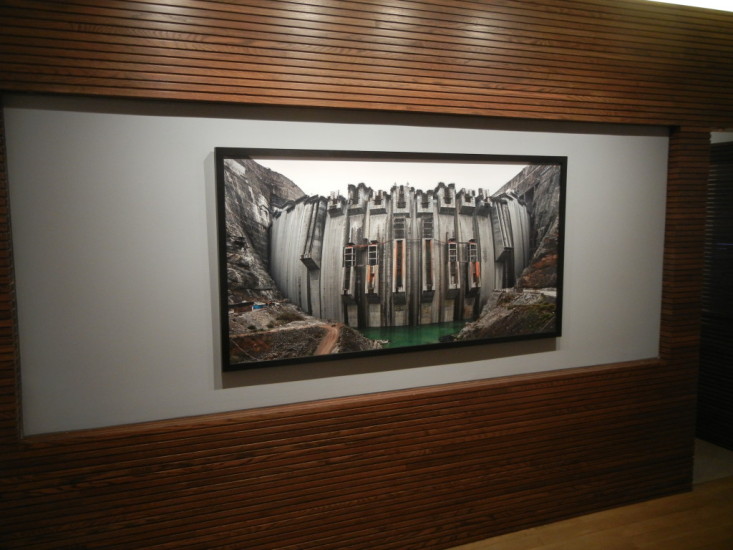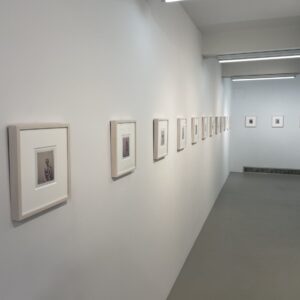JTF (just the facts): A total of 42 large scale color photographs, framed in dark wood and unmatted, and displayed in a paired exhibition, split between Howard Greenberg Gallery (24 works) and Bryce Wolkowitz Gallery (18 works). All of the works in both locations are chromogenic prints, made between 2009 and 2013 and printed in 2013. The standard prints come in three sizes: 39×52 (in editions of 9), 48×64 (in editions of 6), and 60×80 (in editions of 3); wider, more panoramic images vary in size from 29×96 to 48×69, in editions ranging from 3 to 12. At the Greenberg location, the works are spread between the main gallery space, the book alcove, a smaller side room, and the second gallery area, and the show has a larger percentage of smaller prints; at the Wolkowitz location, the works are shown in the front gallery, the main gallery in back, and the smaller side room, and there are more of the larger prints on view. Both locations are screening a short video entitled Where I Stand in side room. A monograph of this body of work was recently published by Steidl (here). (Installation shots for both locations below, in a slideshow.)
Comments/Context: While many contemporary photographers are now comfortable with monumental sized imagery, few are as intrinsically interested in scale as Edward Burtynsky. In project after project, he has tested the limits of photographic scale and shown us increasingly innovative views of industrial mines and quarries, shipbreaking in Bangladesh, factories in China, and more recently, the massive extended scope of the global oil industry. His ambitious new pictures reach even further, documenting the various and essential roles of water around the globe, broadly stretching from natural sources to man-made uses and consequences. Employing a dazzlingly complex set of technological tools to extend his ability to look out across vast spaces, Burtynsky audaciously attempts to tell a comprehensive, almost encyclopedic story of the impact of water on our lives, and ultimately delivers a handful of standout images that astonish us with their breathtaking range.
Burtynsky is at his best when he captures the improbable immensity of human endeavor, and many of his eye in the sky aerial views turn his subjects into geometric abstractions. When seen from elevated vantage points, rice terraces, sewage treatment plants, and endless rows of agriculture become monumental linear designs, while step wells, dams, and power stations are turned into squared off compositions, water being managed with rigid precision. His excellent pictures of marine aquaculture in China and greenhouses in Spain show vast expanses of tiny floating squares and angled plastic rooflines, seemingly extending for miles, and circular green fields of perfect pivot irrigation and the blood red pools of salterns bring splashes of unexpected color into his palette. The terrific short film showing Burtynsky and his team at work with impossibly long pole extenders, remote control helicopters, crane mounted cameras, and other technological marvels is absolutely worth spending a few minutes to watch, as it offers a behind the scenes a glimpse of the complicated background process required to capture these gargantuan views.
My biggest knock on Burtnysky’s Water project is that it seems more consciously politically correct than his prior work, which unfortunately weakens its ultimate impact. Aside from a pair of starkly bisected views of lush suburbs/farmland and dry desert, there are few images here that push hard on the audience, forcing us to face the real water challenges and choices that are coming for the planet. Plenty of beautifully decorative landscapes of pure Icelandic glaciers and waterways, snow capped mountains, and feathering river deltas are mixed in with the man-altered landscapes, creating a back and forth movement that dilutes the power of both sets of works. And even though I can grasp what Burtynsky was after, I found the coastal images of crowded beaches and impossibly dense gatherings of Indian pilgrims equally forgettable.
In many ways, while this show expands to fill the gallery spaces at both Howard Greenberg and Bryce Wolkowitz, both exhibits feel cramped, like there wasn’t enough physical space available to show the pictures the way they need to be seen. Perhaps the show would have benefitted from being organized into discrete subject matter groups, where like images of elemental source landscapes could resonate with each other, and more distressing images of agriculture and aquaculture could interact elsewhere with some breathing space in between; in this manner, the viewer could be taken through a series of discrete visual arguments, rather than having those same ideas thrown into a confused jumble. While his aspirations are laudable, I think that Burtynsky’s project ultimately suffers from a need for tighter curating and editing. I certainly came away excited by a handful of memorable photographs of amazing scale, but was even more frustrated by what seemed like a missed opportunity to be more consistently opinionated and aggressive with his content. Given the central place of water in our lives and the urgency of many of its open questions, Burtynsky has offered us one too many overly nice pictures.
Collector’s POV: The prints in both shows are priced using the same pricing schedule. 39×52 prints are $18000 each, 48×64 prints are $25000 or $35000, and 60×80 prints are $40000 or $42000 each. The various wider panoramas are priced between $25000 and $38000, and there is one 48×64 diptych priced at $45500. Burtynsky’s prints have become more available in the secondary markets in recent years, with prices at auction ranging between roughly $5000 and $48000.





















